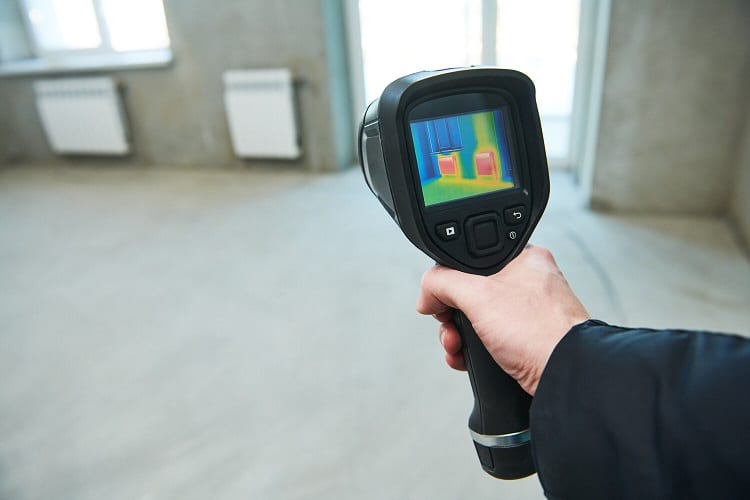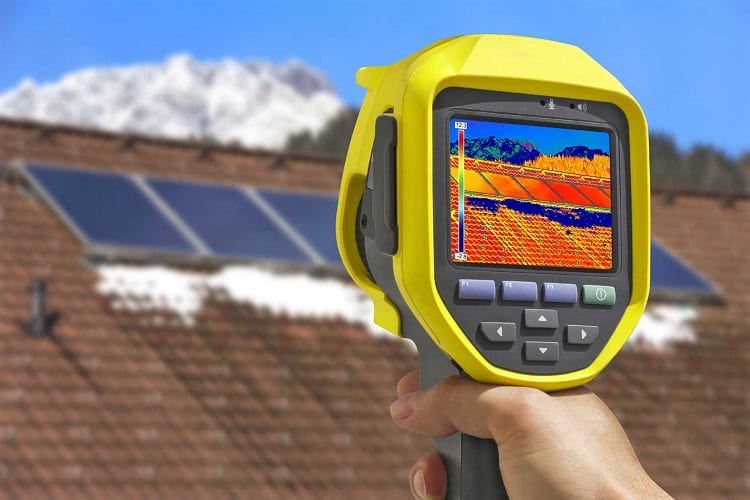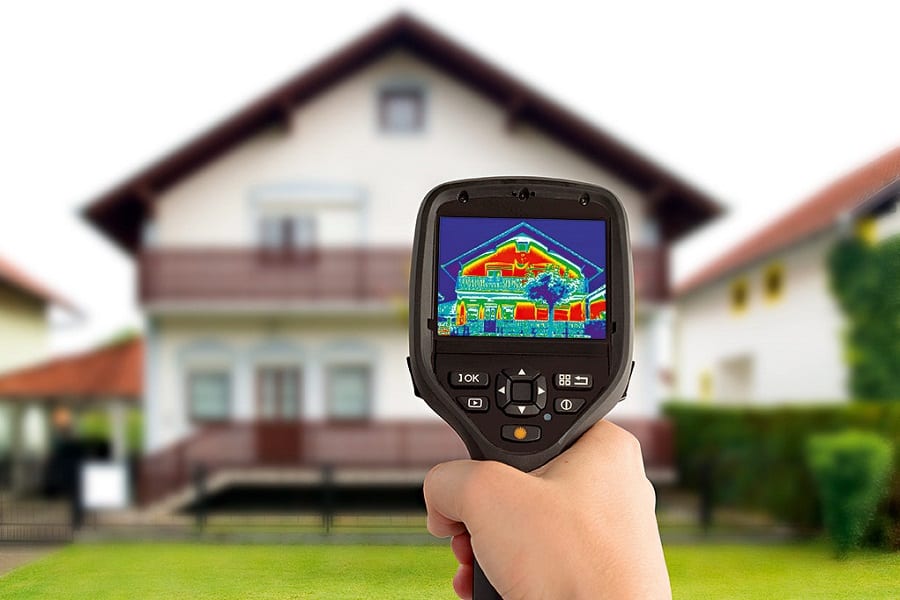Thermal cameras aren’t some high-end military-grade tech that you use to see people through walls (although you can kind of do that, but it’s not the point).
They’re primarily used in construction, demolition, and home renovations. That sounds a bit vague, which is why we’re going to lock in on four thermal camera uses in specifics.
Whether you want to get into construction or just want to have all the necessary tools at your disposal for come-what-may, a thermal camera and its many uses might just be the next addition to your tool kit.
Let’s take a look at where and when they come in handy.
Contents
1. Detecting Heat and Cold Loss Drafts

This is definitely the number one reason that every homeowner should have a thermal camera: for energy efficiency.
We all want to be more energy efficient for our own wallets, and to slow the toll taken on the environment, but most of us don’t know how to do it.
You shouldn’t freeze in the winter, or boil alive in the summer: that AC and heater need to be on. With a thermal camera, you can minimize the amount of time that it needs to be on, though.
There are a handful of areas in your home that drafts can come through, with you being completely oblivious to the fact.
If you have a home with wood siding, all that expanding and contracting will expedite some of these issues. Check out your:
- Window Frames: Mostly around the bottom of your frame, but it can be around the entire thing. It’s easy for air to slip in through here after constant expansion and retraction in the wood surrounding your window. When you install a window, it’s very tense and tight in that spot, and doesn’t move with the house in hot and cold weather. This is the most common spot you’re going to see drafts and heat loss.
- Doors With Exterior Access: If the door leads to the outside world, you’re going to run into similar problems with the door frame that you’ll see with the window frames. Doors are constantly opening and closing, sending vibrations through the frame that can create cracks and widen crevices around your doors.
- Attic Areas: There’s so much space to cover up here. Even if you just have a narrow little crawlspace-like attic, you can still run into dozens (if not, hundreds) of little areas that heat is escaping from, and the cold seeps in from. Your roof takes all the erosion from constant rainfall, and still keeps an airtight seal on the attic. But the thing is, not every roof shingle was installed 100% perfectly, and not every individual shingle undergoes the same amount of pressure over the years. They can and will fail, but your thermal camera can find out where.
- Basements and Crawl Spaces: Crawl spaces need to be checked constantly. With the way that heavy rain can move the dirt, and the stress that your floors go through over time, you can expect some creaks and air leaks every now and again. Basements are a different story, because they’re usually drafty. Concrete walls are generally thick and avoid air leaks, but you should still look around window frames, rafters, and where the basement connects to your house.
- Outlet Covers: Seems crazy, right? The outlet plugs go straight to the wiring, but the edges of your outlet plugs could be sucking in hot or cold air from your room, and leaking it into the walls. This is a small thing to check, but if you’re using a thermal camera to ensure energy efficiency, you shouldn’t leave any stones unturned.
- Chimneys and Range Hoods: Chimneys are basically just giant ducts to suck out the heat and bring in the cold (or vice versa). If you aren’t using your chimney, you can seal it, or at least cover it for the season. A thermal camera will let you know if you sealed it properly, or if you should revisit it and fix any issues.
2. Finding Leaks in the Roof

Rain is cold when it comes down.
Regardless of when it comes down, it’s colder than the air temperature here on the surface.
If rain is leaking into your roof, it’s going to leave behind a cold, wet patch from the top that’s getting hit with more rain.
You can use a thermal camera to inspect the linings of your roof to see if these cold spots are popping up.
3. Inspecting Electrical Wiring
Nearly every single electrical fire is preventable (apart from freak surges and what not).
Thermal cameras allow you to see hot spots in the wall where wiring may have come loose, because believe it or not, your electrical wiring isn’t supposed to run hot despite how much power it’s packing.
Your electrical wiring should maintain a regular temperature. Your thermal camera can detect faulty wiring that’s heating up, which could potentially cause a house fire.
Consider this an investment in your safety, and the safety of your family.
4. Locating Blockages in Pipes
This one is a little bit trickier, but if your pipes are blocked and you can’t detect where, a thermal camera can help you out.
All you have to do is run hot or cold water, and let the sink fill up a bit. Use the thermal camera to see where the heat or cold ends in the pipes, and you’re good to go.
I mean, there’s still the question of fixing it, but this lets you know how big it is, potentially what it is (hair, sock, etc.), so you can create an action plan to take care of it.
Do Thermal Imaging Phone Apps Work?

Just like with stud finders, a phone app isn’t going to do the trick.
The camera in your phone—and I don’t care what phone you’re using, or what generation—doesn’t have the hardware to detect thermal imaging through walls, or even just in front of you.
Thermal cameras can cost you upwards of $25,000, but there are phone attachments that you can use with your Galaxy or iPhone.
Notice I mentioned attachments and not apps. These attachments hook onto your phone, and input the information through the attached camera to your phone.
It’s like using a desktop computer: the power isn’t in the monitor, the monitor is simply displaying what the PC is doing.
These attachments include hundreds, if not, thousands of infrared thermometers.
These are equivalent to the infrared thermometers that nurses sometimes use, where the red beam touches your forehead to detect your temperature.
Now just picture that there’s a massive amount of them, and each individual read shows a different temperature.
That’s how the images are formed together. Using edging technology, a good infrared camera fills in the image seen through its lens with heat signatures, like a color-by-number.
The information is then displayed on your camera screen, or on your phone through an attachment. That being said, an app without an actual infrared camera is useless.
Useful for More Than You Think
If you find yourself doing anything in construction as a career, or if you want to inspect your own home, even expand it, you’re going to need a thermal camera.
You can get more intel with less damage, and a product that lasts 20-30 years (if you maintain it).
For those in or planning to get into a career in construction, thermal cameras can come in handy.


